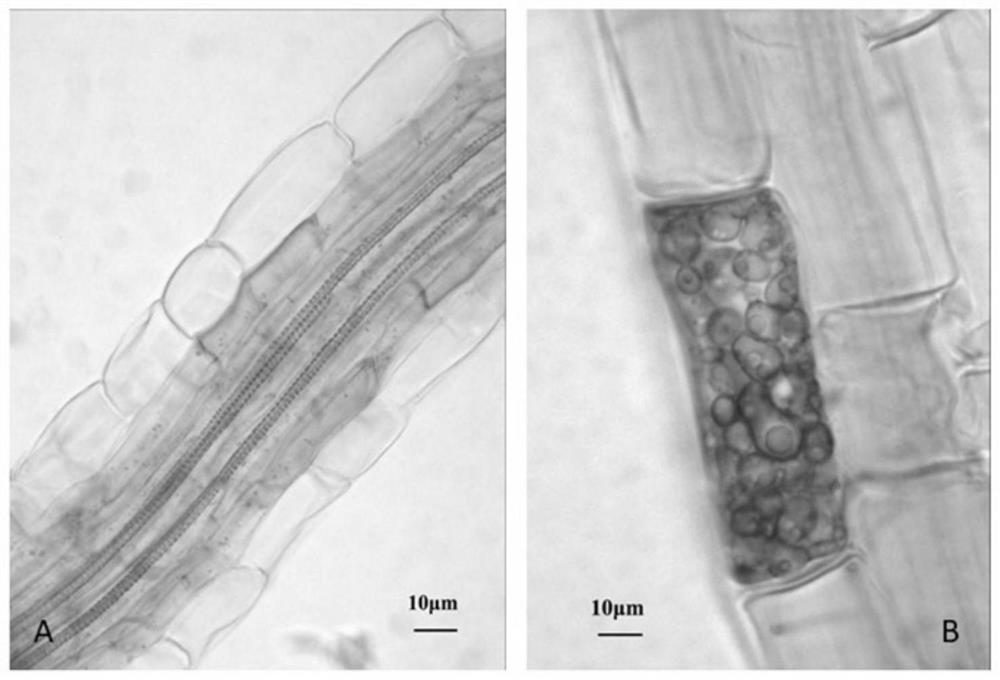A kind of dark septate endophyte fungus on blueberry roots and application thereof
A dark-colored endogenous, blueberry technology, applied in the application field of microbial technology, can solve the problems of being susceptible to adversity stress, lack of flora, slender and underdeveloped blueberry root system, etc., to promote blueberry growth, promote growth, and strengthen plants. The effect of disease resistance
- Summary
- Abstract
- Description
- Claims
- Application Information
AI Technical Summary
Problems solved by technology
Method used
Image
Examples
preparation example Construction
[0042] Further, the preparation method of the fermentation filtrate of the blueberry DSE bacterial strain comprises: the blueberry DSE bacterial strain is cultivated on the PDA medium for two weeks, gets two bacterium cakes (7mm), adds 70ml liquid PDA medium, 25 ℃ 150r / min, shakes Bacteria 2 weeks to make fermentation broth.
[0043] Further, the blueberry DSE strain uses the plate confrontation method to antagonize blueberry pathogenic bacteria or antagonize Sclerotinia sclerotiorum. For example, use a hole puncher with an inner diameter of 6mm to punch out bacteria cakes at the edge of blueberry pathogenic bacteria and blueberry DSE strains, and put them into a petri dish with a diameter of 9cm. The distance between the two cakes and the edge of the petri dish is 3cm. Culture at constant temperature for 5-7 days.
[0044] Further, the 836bp 28s nrDNA sequence of the Pezicula sp.FLR13 is shown in the sequence listing SEQ ID No.1.
[0045]Further, the 499bp ITS sequence of P...
Embodiment 1
[0047] Example 1 Isolation and identification of FLR13
[0048] 1. Isolation and purification of blueberry endophytic fungi
[0049] The test material is the 15-year-old blueberry variety "Fenlan". Randomly select 3 trees, take samples from the east and west directions, remove the 5cm-thick topsoil and collect 5-20cm-deep fibrous roots connected to the main root, then put them together with the soil in a ziplock bag, put them in a refrigerator at 4°C and store them at Processed within 24 hours. Randomly select 2 cm root samples from each plant sample, rinse them with tap water, rinse with 75% ethanol for 1 min, rinse with sterile water for 3 times, disinfect with 0.1% mercury liter for 5 to 10 min, rinse with sterile water for 5 times, place in sterile On the filter paper, remove both ends of the root, cut the root sample into 5mm-sized tissue pieces, put them into culture dishes, 4-5 pieces per dish, randomly select 100-150 tissue pieces, and culture at a constant temper...
Embodiment 2
[0067] Example 2 Morphological and molecular biological identification of FLR13
[0068] 1. Morphological identification FLR13 bacteria cake with a diameter of 5mm was placed on a PDA plate and incubated at a constant temperature of 26°C for two weeks. The bacterial strain grows slowly, cultivated for two weeks, and the colony diameter is 22.4 ± 2.2cm, white, and does not produce spores ( figure 2 A). The morphological characteristics of the hyphae were observed under the microscope. The hyphae of FLR13 were hyphae with septa. When the hyphae grew to a certain stage, they produced protrusions, invaded adjacent hyphae, and mycelium fusion occurred. The content of the cells increased, and the hyphae became thicker ( figure 2 B). At the same time, the hyphae are intertwined into a rope shape, cell fusion occurs continuously around the rope-like hyphae, and the mycelium knot increases and thickens ( figure 2 C).
[0069] 2. Molecular biological identification
[0070] G...
PUM
 Login to View More
Login to View More Abstract
Description
Claims
Application Information
 Login to View More
Login to View More - R&D
- Intellectual Property
- Life Sciences
- Materials
- Tech Scout
- Unparalleled Data Quality
- Higher Quality Content
- 60% Fewer Hallucinations
Browse by: Latest US Patents, China's latest patents, Technical Efficacy Thesaurus, Application Domain, Technology Topic, Popular Technical Reports.
© 2025 PatSnap. All rights reserved.Legal|Privacy policy|Modern Slavery Act Transparency Statement|Sitemap|About US| Contact US: help@patsnap.com



